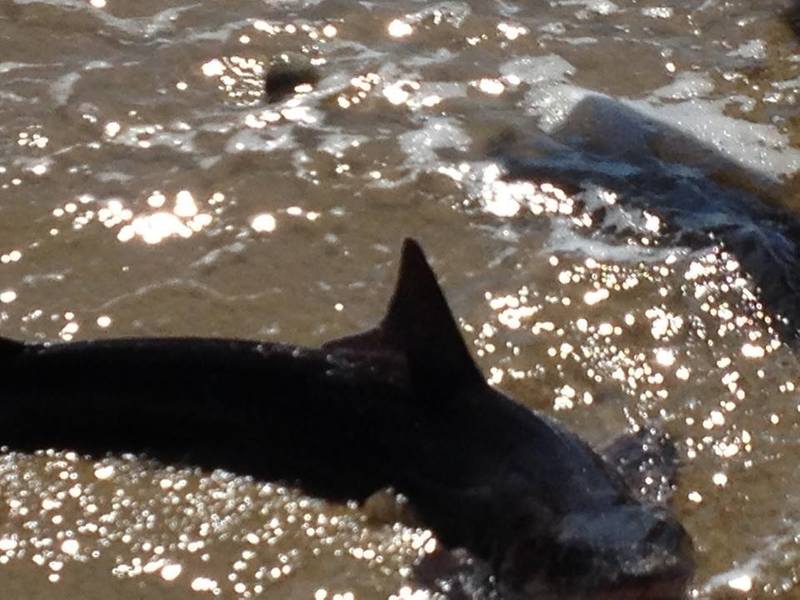Boy recovering after shark bite at state park

Sixteen-year-old Andrew Vance said June 9 was the first time he'd ever been to the beach at Cape Henlopen State Park. It might also be the last.
While the Delmar teen was swimming with his sisters and friends in the shallows about 5 p.m., Andrew felt something latch onto his left forearm. It turned out to be every swimmer's worst nightmare – a shark.
"I pulled my arm all the way out of the water, and I saw the shark," he said. "My first reaction was to punch it in the nose, but it didn't let go. So I put my thumb in his mouth to pry it open and that's when he swam away."
The gashes on Andrew's left forearm required 23 stitches. Lifeguards on duty at the park treated his cuts, and Lewes Fire Department transported the teenager to Beebe Healthcare by ambulance. Andrew said he was at Beebe no more than 15 minutes after the shark bit him.
News of the shark bite went viral, and Andrew said he is shocked by the media attention he is receiving. Many friends are calling him a celebrity on Facebook, and the story has reached publications in New York City and London.
Judging by the bite, DNREC Marine Biologist Scott Newlin said June 10 he believes it came from a 3-foot long juvenile sand bar shark – a common shark off the Delaware coast.
"A larger shark would've pulled him down and taken a lot more flesh with it," he said.
For his part, Andrew estimates the shark was closer to 5 or 6 feet, with a brownish, grayish head.
Newlin said he doubts the shark attacked Vance; it may have been going after a fish, and the boy's arm got in the way.
Evening is typical feeding time for sharks, and the boy's 5 p.m. swim was prime time for dinner, Newlin said.
"I don't think there is much concern for the public now," Newlin said. "But it's best to steer clear of the water especially after dark."
Newlin said he does not recall a shark attack off the Delaware Coast. Incidents of shark bites are also rare. According to data gathered at the Global Shark Attack website, there have been six reported shark bites since 1909 – the last occurring in 2007 while someone was fishing in the Indian River Inlet.
Andrew said he goes to the beach every weekend in the summer, usually to Rehoboth Beach or Ocean City. In all of his time swimming in the ocean, he said, this is the first time he's ever seen a shark in the water.
Beaches at Cape Henlopen State Park were initially closed June 10, but reopened in the afternoon after Department of Natural Resources and Environmental Control officials flew over the shoreline in a helicopter and saw no shark activity, said Michael Globetti, DNREC spokesman.
DNREC Secretary Collin O'Mara considers the shark bite an isolated incident, Globetti said.
About four dozen beachgoers were set up along the beach at the end of the pavillion walkway at about 11 a.m. A red no-swimming flag warned beachgoers to stay out of the water.
Vacationer Scott Zitzer of Luray, Va., surveyed the beach before descending on the sand with his family. Looking over the calm ocean, he said he was not very concerned about sharks along the Delaware coast.
"I don't think there will be a problem," he said.
Lewes resident Ellen Dodd was finishing her morning walk along the beach, and she also won't let the shark scare keep her out of the water.
"I think if it got hot, I'd go back in the water," she said.
Dewey Beach Patrol Capt. Todd Fritchman said this was the first time in his 34 years as a lifeguard on Delaware's beaches that he's heard of a significant biting event. He said there have been minor instances, but nothing this profound.
Sharks are out there all the time, he said. This area is their reproductive grounds, and sharks are predatory fish that follow bait fish into the shallows, he said.
Fritchman said Dewey Beach is open. News of the shark bite has not changed the way the patrol approaches marine activity.
“We're always highly active with our watch,” he said. “We're always on our A game.”
Dewey Beach has an extensive protocol to follow in the case of marine activity, said Fritchman. If there is marine activity in the surf zone, a buffer zone is immediately set up.
Fritchman said a contributing factor could be an increase in surf fishing along the state's beaches. He said fishermen using chum could be bringing sharks into shallower waters and closer to humans.
Rich King, an avid fisherman who runs the popular Delaware Surf Fishing website, disagrees that surf fishing is bringing sharks closer to humans.
“People fishing from the beach are not attracting sharks,” he said. “You've got a better chance of being run over by a cow than you do being bitten by a shark.”
King said he tells people all the time that it's a whole different food chain in knee-deep water.
“If people could see what is in the water and see what is really going on, it would blow their mind,” he said. “Especially the fishermen who aren't catching anything.”
King said he has seen a photo that's been posted on the internet that reports to show the young man's injuries, and he said by the looks of it, the shark was probably something small.
“This is not a 'Jaws' situation,” he said. “If it were a big sand shark, it could have taken his arm off.”
King said the temperature of local ocean waters were slow to rise this year, and that seems to have played a part in a migration of sharks that's heavier than normal. He said he was fishing this weekend off the beach and saw all kinds of people pulling up little sand sharks.
“Sharks line our oceans. The Delaware Bay is a nursery for tiger sharks,” he said.
Andrew said the stitches will be removed in 10 to 14 days. After everything is healed, he said, he'll be going back in the water.





















































